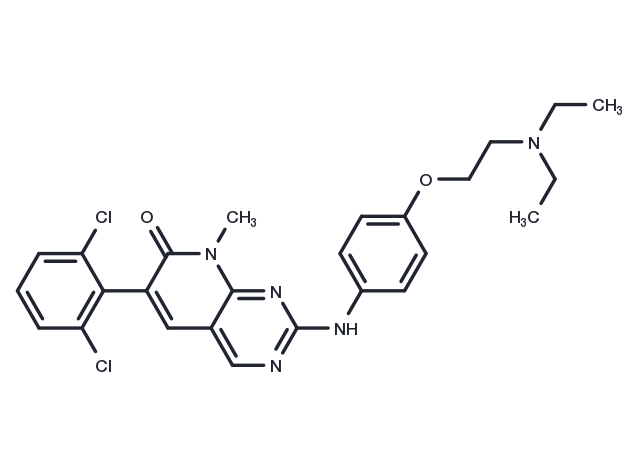Powder: -20°C for 3 years | In solvent: -80°C for 1 year


PD0166285 is a potent Wee1 and Chk1 inhibitor with activity at nanomolar concentrations.PD0166285 is a novel G2 checkpoint abrogator.

| Pack Size | Availability | Price/USD | Quantity |
|---|---|---|---|
| 1 mg | In stock | $ 52.00 | |
| 2 mg | In stock | $ 73.00 | |
| 5 mg | In stock | $ 132.00 | |
| 10 mg | In stock | $ 210.00 | |
| 25 mg | In stock | $ 462.00 | |
| 50 mg | In stock | $ 678.00 | |
| 100 mg | In stock | $ 966.00 | |
| 500 mg | In stock | $ 1,930.00 | |
| 1 mL * 10 mM (in DMSO) | In stock | $ 148.00 |


| Description | PD0166285 is a potent Wee1 and Chk1 inhibitor with activity at nanomolar concentrations.PD0166285 is a novel G2 checkpoint abrogator. |
| Targets&IC50 | Chk1:3.4 μM, Myt1:72 nM, Wee1:24 nM |
| In vitro | PD0166285 is identified to inhibit Wee1 activity at nanomolar concentrations. The inhibitor abrogates G2/M checkpoint inducing early cell division. At the cellular level, 0.5 μM PD0166285 dramatically inhibits irradiation-induced Cdc2 phosphorylation at the Tyr-15 and Thr-14 in seven of seven cancer cell lines tested. This G2 checkpoint abrogation by PD0166285 is demonstrated to kill cancer cells. PD0166285 does not inhibit Cdc2/cyclin B but inhibits Chk1 kinase at a much higher concentration (3433 nM). the treatment of cells with the inhibitor is related to microtubule stabilization and decrease in cyclin D transcription. Thus, PD0166285 may be a potentially useful anti-cancer therapy[1][2]. |
| In vivo | PD0166285 at 0.5 μM concentration can inhibit Cdc2Y15 /T14 phosphorylation in all cell lines tested, regardless of their p53 status[1] and pharmacological targeting of WEE1 by PD0166285 sensitizes U251-FM GBM tumors to IR in vivo[3]. |
| Kinase Assay | Wee1 Mass Screening: Wee1 mass screening is performed using Amersham's p34cdc2 kinase SPA kit with some modifications. Briefly, 45–60 nM full-length Wee1 kinase is incubated with 25 μM compounds, 20 μM ATP, and 122–441 nM Cdc2/cyclin B in a final volume of 50 μl of enzyme dilution buffer [50 mM Tris (pH 8.0), 10 mM NaCl, 10 mM MgCl2, 1 mM DTT, and 0.1 mM Na3VO4]. After 30 min incubation at 30°C, 30 μl of [33P]ATP containing kinase buffer [67 mM Tris (pH 8.0), 40 mM NaCl, 13 mM MgCl2, 1 mM DTT, and 0.13 mM Na3VO4] containing 1 μM biotinylated peptide, and 0.25 μCi of [γ-33P]ATP is added to the reaction and incubated for another 30 min at 30°C. The reaction is stopped by adding 200 μl of stop buffer [50 μM ATP, 5 mM EDTA, 0.1% Triton X-100, and 1.25 mg/ml SPA beads in PBS]. After centrifugation at 2400 rpm for 15 min, the plate is counted with Wallac's Microbeta counter. |
| Cell Research | B16 cells (1 × 105 cells in 100 mm-dishes) are maintained in medium overnight. In addition, the cells are treated with (0, 0.5, 1.0, or 2.0 μM) PD0166285 (including DMSO vehicle) for indicated times. The cells are washed twice with phosphate-buffered saline (PBS). Next, the cells are trypsinized, so the cell numbers in each dish are determined by using a computed cell-counter (Sysmex CDA-500) according to manufacturer's recommendation. (Only for Reference) |
| Animal Research | E98 tumor fragments (8 mm3) were grafted subcutaneously in the flank of Balb/C nude mice (n = 10). For the experiments with the orthotopic tumors, U251 mg and E98 cells were transduced to express Fluc and mCherry, to generate U251-FM and E98-FM cells. One million cells were injected intracranially. Starting at 12 days after tumor inoculation, mice received the WEE1 inhibitor PD0166285 via intraperitoneal injections (500 μl of a 20 μM solution diluted in NaCl) or vehicle for 5 consecutive days. On days 10–15, mice were irradiated with a single dose of irradiation. |
| Synonyms | PD-166285 |
| Molecular Weight | 512.43 |
| Formula | C26H27Cl2N5O2 |
| CAS No. | 185039-89-8 |
Powder: -20°C for 3 years | In solvent: -80°C for 1 year
Ethanol: 93 mg/mL (181.5 mM)
DMSO: 93 mg/mL (181.5 mM)
H2O: < 1 mg/mL (insoluble or slightly soluble)
You can also refer to dose conversion for different animals. More
bottom
Please see Inhibitor Handling Instructions for more frequently ask questions. Topics include: how to prepare stock solutions, how to store products, and cautions on cell-based assays & animal experiments, etc.
PD0166285 185039-89-8 Apoptosis Cell Cycle/Checkpoint Chk Wee1 PD 166285 Inhibitor inhibit PD-166285 PD166285 PD-0166285 PD 0166285 inhibitor
